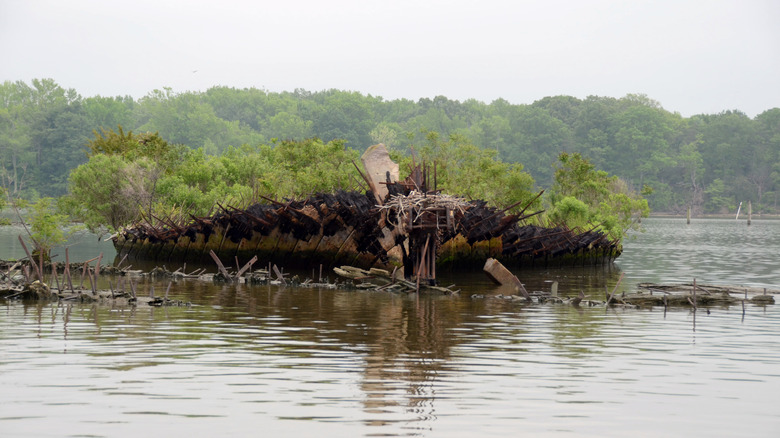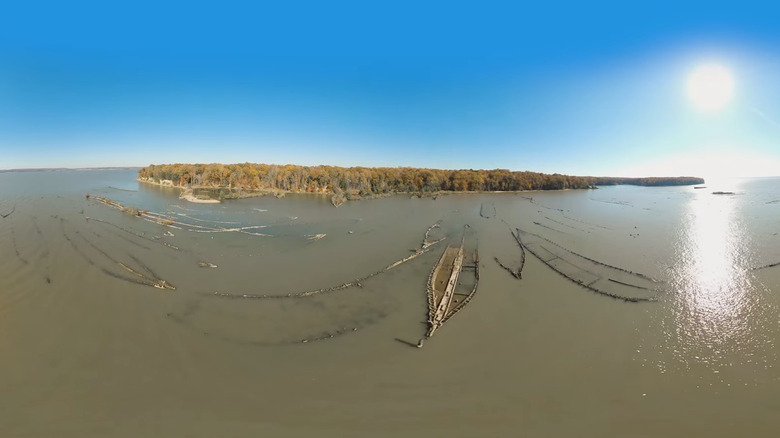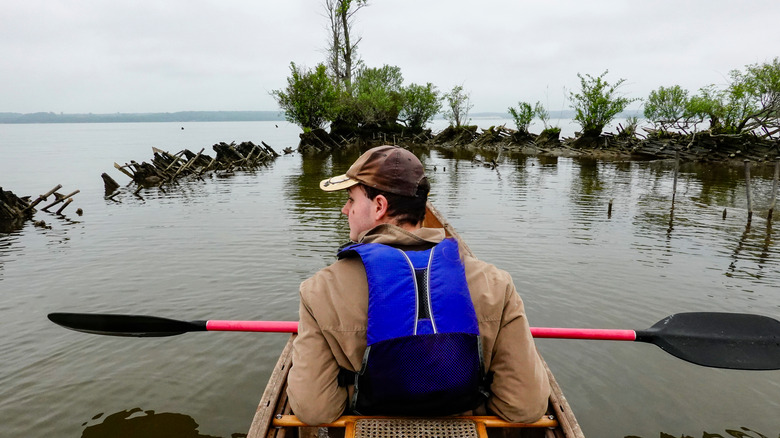Just Outside Washington, DC, A Fascinating Maryland Marine Sanctuary Preserves World War I-Era History
The Potomac River is full of surprises, from charming towns with the longest beaches to opportunities for boating and spending time on the water. Imagine a paddling trip through history, with beautiful natural scenery and countless shipwrecks everywhere you look. That's the view you get at the Mallows Bay-Potomac River National Marine Sanctuary, located about 40 miles down the Potomac River from Washington, D.C. It's one of the best paddle destinations in America, yet few have heard about it. But the story of Mallows Bay is an interesting one, and the site is well worth a visit.
Part of the Captain John Smith Chesapeake National Historic Trail, Mallows Bay is itself a gorgeous place. Tucked in a rural area on the Maryland side of the Potomac, it's surrounded by green forests and abounds with wildlife. There are sandy shorelines to pull off for a picnic, and the numerous shipwrecks mean that boat traffic is minimal. Mallows Bay is home to the Ghost Fleet, a massive collection of vessels that were scuttled here over the years between the Revolutionary War and World War II. Today, their hulks remain visible, making for a spectacular spot to explore by kayak, canoe, or small boat. The marine sanctuary was established in 2019 to protect the bay and raise awareness of its significance.
Exploring the Ghost Fleet of Mallows Bay
In total, there are around 200 shipwrecks in Mallows Bay. Most of them are from the World War I era, when German U-boats were sinking hundreds of merchant ships every month. The U.S. began rapidly making more ships, but due to delays and shortages, many remained unfinished after the war had ended. The incomplete ships were then purchased by a salvage company and brought to the Potomac. In total, 169 of these ships were burned, sunk, or abandoned. But those ships weren't even the first ones sunk here — wrecks have been found that date as far back as the 17th century, including vessels from both the Revolutionary and Civil Wars. The most recent vessel to lie in Mallows Bay is the Accomac. Left in the 1970s, it was a steel-hulled ferry that operated between Cape Charles and Norfolk.
Many of the shipwrecks are clearly visible today, exposed in shallow water. But you can only barely glimpse them from land, so the best views are obtained by kayaking around the bay. A nearby park boat ramp allows easy access, and you'll see some ships easily identifiable, and some are nothing more than wooden beams sticking out of the water. Still others have become ship-shaped islands of vegetation that have grown up over the decades. A paddler's guide from the sanctuary provides history and details on the visible wrecks. You might think all this wreckage would be an ecological disaster, but over the years, nature has taken back Mallows Bay. Paddlers visiting today are treated to a variety of bird life that makes the area home, like the many ospreys, eagles, and herons you're sure to see. Besides sightseers, you'll probably notice a few anglers trying their luck for bass and catfish.
Visiting Mallows Bay and the Maryland Potomac
To paddle the Ghost Fleet, you'll start at Mallows Bay Park, 28 miles southwest of Waldorf, Maryland, and 44 miles south of the District of Columbia. In addition to the boat ramp and parking area, the park has several nature trails. From an overlook, it's possible to see some of the Ghost Fleet with the provided telescope. There are no kayak rentals on-site, and the sanctuary advises against using inflatable kayaks and paddleboards due to the submerged hazards. You can also join a tour through Atlantic Kayak in Indian Head, Maryland. It's one of the most unique activities you can do on a Washington, D.C., vacation.
If you're flying in, you'll want to arrive at one of the D.C. area airports — Reagan is nearest, but Dulles or even Baltimore are within a two-hour drive. There are a few places to stay in Indian Head, but you'll find many choices in the city of Waldorf. If you want to stay by the river, the only options in this rural area are rentals from Airbnb or Vrbo. For about $300 per night, you can rent a three-bedroom waterfront home with a dock.
The best time to visit Mallows Bay for kayaking is between May and September, when both the air and water are warm. But it can be pretty hot and muggy in the afternoons, and there is the risk of thunderstorms, so morning paddles are preferable. You'll never be far from shore while exploring the cove, but you'll want to keep a careful eye on marine conditions and avoid times of strong winds or possible storms. To get the best view of the wrecks, try to time your paddle with low tide.


